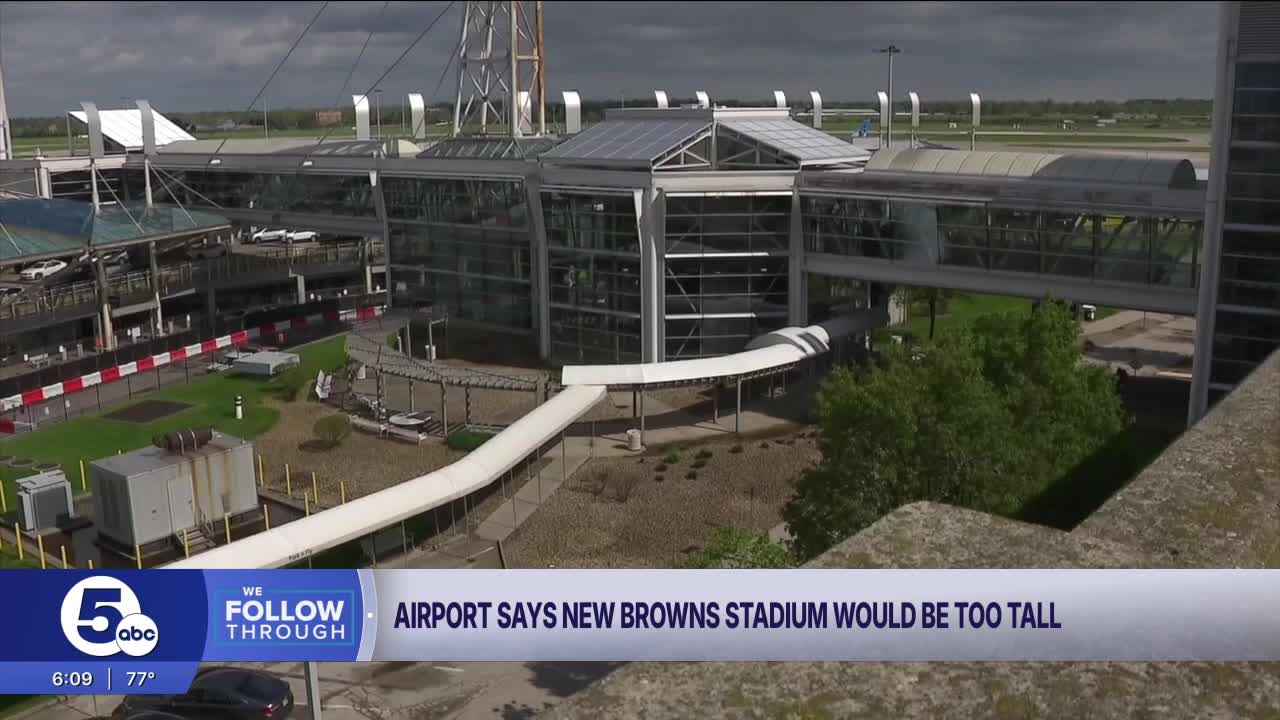CLEVELAND — Cleveland’s top airport official says the proposed Browns stadium development in Brook Park would “permanently and negatively impact” the airspace at Cleveland Hopkins International Airport, interfering with operations, safety and more.
That’s what Bryant Francis, the city’s director of port control, wrote in a letter to the Ohio Department of Transportation’s aviation office in March. Francis doubled down on his stance in late June, according to public records released Monday.
That correspondence is what prompted ODOT aviation officials to deny a permit this month for the new Browns stadium – even though the proposal, on a 176-acre former automotive-plant site just east of Hopkins, won approval from the Federal Aviation Administration in May.
RELATED: ODOT rejects new Browns stadium as too tall. Browns push back, citing FAA's OK.
ODOT and the city of Cleveland provided the letters to News 5 in response to a public records request. In March, Francis told state officials that the project would intrude on the airspace at Hopkins, forcing changes to approach minimums for pilots.
“The proposed building development would have a negative impact on all aircraft types that would typically use CLE,” Francis wrote, using the code for Hopkins.
He added that the project would cause particular problems for Runway 28, an east-west runway that runs parallel to nearby Brookpark Road. “This would have the potential for a reduction in safe operations,” Francis wrote.
Airport officials have not responded to follow-up questions or interview requests.
Based on that pushback from Hopkins, ODOT’s aviation office recently rejected the stadium development as too tall. The agency says it defers to local airports in situations where there is a difference in opinion between Ohio airport officials and the FAA.
Now ODOT is asking the Browns to either shave 58 feet off the stadium project, file an administrative appeal and seek a formal hearing, or work with Hopkins to change the airport’s stance.
The permit denial, which ODOT sent to an aviation lawyer working with the Browns, came as a late-in-the-game surprise to team owner Haslam Sports Group, which is racing to break ground for the stadium early next year. The Browns hope to move to Brook Park in 2029, after the team’s lease ends at Huntington Bank Field on the Downtown lakefront.
The city of Cleveland owns the existing stadium and is mired in a court battle with the Browns over the team’s moving plans. Cleveland also owns the airport.
RELATED: Is the court fight over between Cleveland and the Browns? Not so fast, mayor says.
In a recent letter to ODOT, an aviation lawyer hired by Haslam Sports Group said the project team never submitted a permit application to the agency.
But ODOT automatically starts a review process when anyone proposing to build or alter a structure near an airport files a notice with the FAA.
An FAA filing triggers an ODOT evaluation to make sure that the construction project complies with state laws and federal safety standards. That process is required for any structure that’s 200 feet high or taller. ODOT also assesses other types of projects near runways and heliports.
An ODOT spokesman said the agency’s aviation office reviews 3,000 to 4,000 such permit applications each year. And it’s not unheard of for the agency to reject a project.
ODOT once denied a permit for a hospital expansion near Dayton Wright Brothers Airport. The hospital ultimately changed its plans to address the airport’s concerns, Matt Bruning, ODOT’s press secretary, wrote in an email Monday.
In Geauga County, ODOT turned down a property owner's proposal to erect a cell phone tower. The height of that tower ended up being reduced after a hearing, Bruning said.
Federal and state aviation workers who vet projects near airports don’t see the details about the structures they’re evaluating. They’re looking at longitudes and latitudes; building heights, sizes and slopes; temporary versus permanent construction; and other basic information.
The Browns’ applications to the FAA don’t mention a pro sports stadium. And they list the project sponsors as an aviation lawyer and an airspace consulting firm – not an NFL team.
Haslam Sports Group and its consultants have until the end of August to request a hearing to challenge ODOT’s decision.
“This structure may also be permitted at your proposed height at another location further away from the airport,” ODOT’s aviation office wrote in the denial letter.
The Browns say they’ll keep working to move the $2.4 billion stadium project – the centerpiece of a broader mixed-use district – toward take-off.
It’s too early to say how much the resistance from Hopkins and ODOT could impact the feasibility, timeline or price tag for the development.
“We’ve already begun working collaboratively with ODOT to explain the stadium’s heights and the detailed work we’ve done more fully, which shows no safety or efficiency issues to Cleveland Hopkins International Airport,” a Browns spokesman wrote in an email last week. “We look forward to resolving this matter expeditiously and continuing our work to bring this transformative project to Northeast Ohio.”






